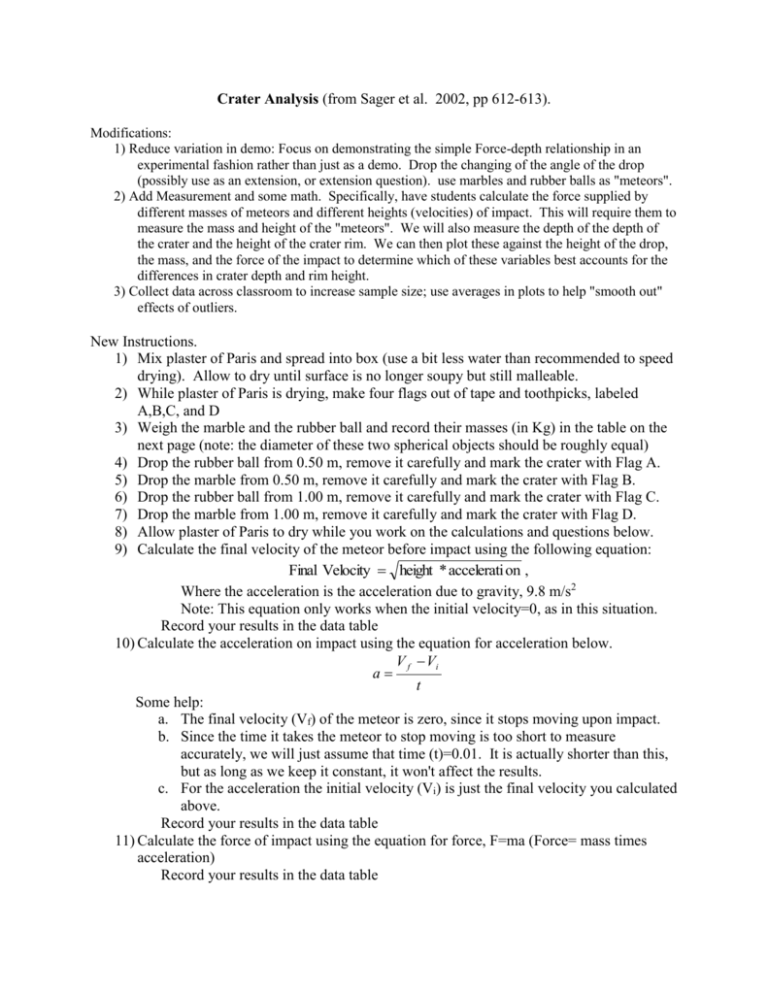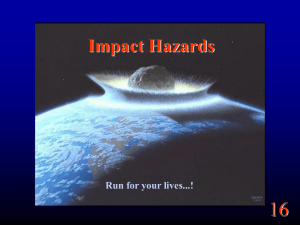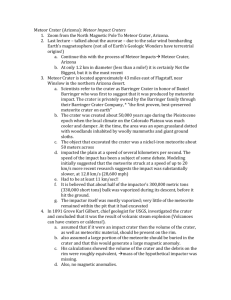Crater Analysis (from Sager et al
advertisement

Crater Analysis (from Sager et al. 2002, pp 612-613). Modifications: 1) Reduce variation in demo: Focus on demonstrating the simple Force-depth relationship in an experimental fashion rather than just as a demo. Drop the changing of the angle of the drop (possibly use as an extension, or extension question). use marbles and rubber balls as "meteors". 2) Add Measurement and some math. Specifically, have students calculate the force supplied by different masses of meteors and different heights (velocities) of impact. This will require them to measure the mass and height of the "meteors". We will also measure the depth of the depth of the crater and the height of the crater rim. We can then plot these against the height of the drop, the mass, and the force of the impact to determine which of these variables best accounts for the differences in crater depth and rim height. 3) Collect data across classroom to increase sample size; use averages in plots to help "smooth out" effects of outliers. New Instructions. 1) Mix plaster of Paris and spread into box (use a bit less water than recommended to speed drying). Allow to dry until surface is no longer soupy but still malleable. 2) While plaster of Paris is drying, make four flags out of tape and toothpicks, labeled A,B,C, and D 3) Weigh the marble and the rubber ball and record their masses (in Kg) in the table on the next page (note: the diameter of these two spherical objects should be roughly equal) 4) Drop the rubber ball from 0.50 m, remove it carefully and mark the crater with Flag A. 5) Drop the marble from 0.50 m, remove it carefully and mark the crater with Flag B. 6) Drop the rubber ball from 1.00 m, remove it carefully and mark the crater with Flag C. 7) Drop the marble from 1.00 m, remove it carefully and mark the crater with Flag D. 8) Allow plaster of Paris to dry while you work on the calculations and questions below. 9) Calculate the final velocity of the meteor before impact using the following equation: Final Velocity height * accelerati on , Where the acceleration is the acceleration due to gravity, 9.8 m/s2 Note: This equation only works when the initial velocity=0, as in this situation. Record your results in the data table 10) Calculate the acceleration on impact using the equation for acceleration below. V f Vi a t Some help: a. The final velocity (Vf) of the meteor is zero, since it stops moving upon impact. b. Since the time it takes the meteor to stop moving is too short to measure accurately, we will just assume that time (t)=0.01. It is actually shorter than this, but as long as we keep it constant, it won't affect the results. c. For the acceleration the initial velocity (Vi) is just the final velocity you calculated above. Record your results in the data table 11) Calculate the force of impact using the equation for force, F=ma (Force= mass times acceleration) Record your results in the data table Questions Q1. Look at your calculations and the equation for final velocity. As the distance you drop the meteor from increases, does the final velocity increase, decrease, or remain unchanged? Q2. As the mass increases does the final velocity increase, decrease, or remain unchanged? Q3. In real life, does the distance a meteor falls change the velocity of the meteor? If not, what do you think might affect the velocity of a meteor? Q4. Look at your calculations and the equation for force. If you increase the mass of the object, does the force increase, decrease, or remain unchanged? Q5. If you increase the velocity prior to impact, does the force increase, decrease, or remain unchanged? Q6. If you increase the mass, does the force increase, decrease, or remain unchanged? Q7. If the meteor impacts a hard surface that stops it faster (that is, t is smaller) would the force increase, decrease, remain unchanged? Q8. What if it impacted a soft surface (like water) that would take a long time to slow it down (t is bigger)? Q9. Meteors do not always impact from directly overhead. How could you simulate a meteor striking the Earth's surface at an angle? Q10. Force is measured in Newtons. Use the equation for force to express Newtons in terms of the base units Kilograms (kg), meters (m), and seconds (s) Table 1. Data collected on objects impacting the plaster of Paris and measurements of the results of those impacts. A: Rubber B: Marble C: Rubber D: Marble ball ball Mass (kg) Height (m) 0.50 0.50 1.00 1.00 Final Velocity (m/s) Acceleration on impact (m/s2) Force of Impact (Newtons, N) Your Crater Depth (mm) Your Height of crater rim (mm) Class Average crater depth (mm) Class average height of crater rim (mm) When the plaster of Paris is dry, use a ruler to measure the depth of each crater and the height of the crater rim, recording this information in the data table. Once you have these measurements, determine which variable is more important in determining crater depth: the mass of the object, the final velocity of the object, or the force of impact. An easy way to see this is make a plot of each of the variables and the Crater depth (for example, plot the mass on the x-axis and the crater depth on the yaxis). Use the grids on the following page to do this. Repeat this procedure with the data on height of crater rim Share your data with the class and calculate the class averages. Does this change your results? In this simulation, we removed our meteors after impact to reveal the craters. In reality, what happens to the meteors, allowing us to see the craters? . Sager, R.L, W.L. Ramsey, C.R. Phillips and F.M. Watenpaugh, 2002. Modern Earth Science. Holt, Rinehart and Winston, Austin Texas, USA









